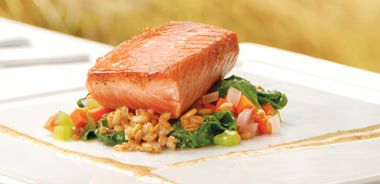Tea-cured Wild Salmon with Wilted Summer Greens, Rye Berry Salad, and Mustard Vinaigrette

Served at any temperature, this dish delivers and offers plenty of room for experimenting with various teas and vinaigrettes. Add another flavour edge by opting for the grill versus the pan for the salmon.
Mustard Vinaigrette
1/4 cup (60 mL) lemon juice
1/4 cup (60 mL) whole grain mustard
3/4 cup (180 mL) extra-virgin olive oil
Salt and pepper, to taste
Combine all ingredients until blended.
Rye Berry Salad
1 cup (250 mL) rye berries, washed
8 cups (2 L) water
1/4 cup (60 mL) carrots, diced
1/4 cup (60 mL) celery root, diced
1/4 cup (60 mL) red onions, diced
4 cloves garlic, crushed
2 whole bay leaves
Salt
1 red pepper, diced
1 yellow pepper, diced
4 oz (125 g) baby spinach, wilted
Place rye berries, water, carrots, celery root, and red onions into a heavy-bottomed pot. Bring to a boil, then turn temperature down and simmer for 2 minutes. Turn off heat and let stand for 1 hour.
Place back on heat and bring back to a simmer; cook for 1 hour or until berries are plump and tender. Drain and adjust seasoning.
Garnish with peppers and baby spinach and dress with a touch of vinaigrette.
Salmon
6 wild salmon fillets, 5-oz (142 g) portions
5 Tbsp (75 mL) smoked tea (e.g., lapsang souchong)
4 tsp (20 mL) sea salt
1 Tbsp (15 mL) brown sugar
Using a spice grinder, process the tea, salt, and sugar into a powder. Sprinkle this mixture onto the exposed flesh of the fish. Refrigerate for 2 hours.
Remove from the fridge and rinse off the brine, pat dry, and bring to room temperature before cooking.
Cook the marinated salmon until just underdone in a frying pan on medium-high heat, placing flesh face down, cooking for 4 minutes, and turning for another 3 minutes before removing from heat. Place salmon atop the rye berry salad and drizzle with vinaigrette.
Serves 6.
source: "C Restaurant", alive #298, August 2007




